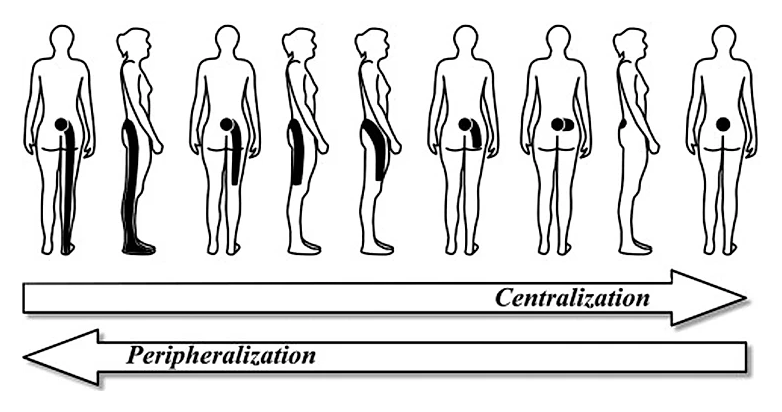One of the more unfortunate and expensive situations in musculoskeletal medicine is that of the Undetected Centralizer. A centralizer refers to someone with whom spinal pain and referred symptoms down an extremity, for example sciatica, are able to have their pain centralized, which means that it is progressively abolished in a distal to proximal direction in response to therapeutic loading strategies, for example movements and postures. The picture of lumbar centralization demonstrates this movement of symptoms.
Before I explain why it is this situation is unfortunate, I will explain why the elicitation of centralization is very fortunate. Centralization is one of the most studied and validated findings in low back pain literature, and is associated with excellent outcomes. A systematic review of centralization prevalence, reliability in its identification, and prognostic studies, entitled The centralization phenomenon of spinal symptoms—a systematic review, concluded that “Centralization appears to identify a substantial subgroup of spinal patients; it is a clinical phenomenon that can be reliably detected, and is associated with a good prognosis. centralization should be monitored in the examination of spinal patients.”
Centralization is elicited through movement in a patient’s Directional Preference, which is discovered through the McKenzie Method (aka Mechanical Diagnosis and Therapy – MDT) assessment process. Directional Preference describes the clinical phenomenon where postures or movements in one direction decrease, abolish or centralize symptoms and improve range of motion. Therefore, all centralizers have a directional preference.
Centralization is also a very reliable indicator that a patient will recover without surgery, even if one or more surgeons feel that the patient is a surgical candidate. In three separate studies, an MDT evaluation was provided to patients just before lumbar surgery (at the 11th hour), with a sizable number (32-52%) reporting Centralization and Directional Preference. In all three of these studies, surgery would have otherwise been performed on most patients, but after these positive prognostic findings were discovered they became non-surgical patients. In essence, the McKenzie Method intervention was a pre-surgical rescue. The percentage reported above doesn’t represent the acute sciatica population, which has a much higher rate of Directional Preference and Centralization compared to the chronic sciatica population.
It is because of this success in patients who otherwise would have undergone lumbar spine surgery that makes the Undetected Centralizer very unfortunate. Most patients would naturally prefer to avoid surgery, especially if they could instead experience a fast recovery using a simple directional preference exercise and posture correction. In addition, the cost savings are enormous, as spinal surgeries can be upwards of $15,000-40,000 or more, not to mention potential complications, failed or partially successful surgery, the chance of a re-operation, and costs of any persisting disability. Compare this to the few hundred dollars that an MDT examination and subsequent treatment costs, and it’s not even a debate.
Large numbers of patients who are centralizers remain undetected because they either haven’t had the opportunity to undergo an MDT assessment, or if they were, it was carried out in in inadequate or incomplete fashion. This happens every day in every city and town, and in every clinic where patients are not provided this evaluation by a clinician properly trained in the MDT assessment process. Therefore there are countless spinal surgeries being performed on patients who are centralizers, and therefore would have great outcomes with the proper conservative care.
The take home message from an article written by two orthopedic surgeons, Ron Donelson, MD and Todd Wetzel, MD, entitled The role of repeated end range/pain response assessment in the management of symptomatic lumbar discs, is that “The evidence is sufficiently strong that LBP patients should not be undergoing disc surgery of any type without first being given the opportunity to be evaluated using this simple and inexpensive form of assessment (MDT).”
The great news is that the McKenzie Method (MDT) is the primary assessment method used in our clinic. You may be one assessment away from changing your life.

